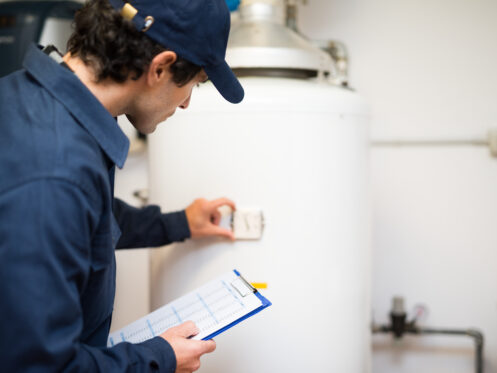Knowing what temperature you should keep your water heater is a matter of preference and what your specific priorities are. Keeping your water heater at a lower temperature will help you save on your energy bills, but setting it slightly higher is better for cleaning and sanitation. Let’s look at the best temperature range for a water heater and also discuss the effects temperature can have on your energy costs and your water heater’s lifespan.
Setting an Optimal Temperature
The first thing to know about water heater temperature is that you always need to leave it set at least 120 degrees Fahrenheit. The reason is to prevent the risk of bacteria and viruses from being present in your hot water. Keeping your water heater set to a minimum of 120 degrees should ensure that the water is hot enough to kill any bacteria and viruses that get inside your hot water tank. The biggest risk in this regard is legionella, the bacteria that causes a type of pneumonia known as Legionnaire’s disease, which is commonly found in warm water. The issue when legionella is present is that it can travel in tiny water droplets, creating a risk of a person breathing the bacteria in and getting sick. There is a small chance that legionella can survive in 120-degree water. As such, if anyone in your household has a compromised immune system or chronic respiratory issues, it’s safer to keep the temperature at 130-140 degrees.
Another thing to note is that you should generally never set the temperature on your water heater to anything higher than 140 degrees. This is just to prevent anyone from potentially being scalded. If you have any young children in your household, it’s generally recommended to leave your water heater at 120-130 degrees to further reduce that risk.
One final factor is whether or not your dishwasher has a booster pump. A booster pump works to increase the water pressure so that a dishwasher can clean more effectively. If your dishwasher doesn’t have such a pump, it may not provide optimum cleaning if your hot water is only 120 degrees. As such, you may want to set your water heater at 130-140 degrees just to ensure your dishes always get fully cleaned and sanitized.
Most water heaters can be turned up as high as 160 degrees, but there’s generally no reason to go any higher than 140 degrees since that is more than sufficient for cleaning and sanitation. The only time you may want to consider turning the temperature on your water heater all the way up is if you’ve been away and had your water heater set on vacation mode. The vacation mode works slightly differently on different water heaters. On some units, it just keeps the water set at around 100 degrees. On other older gas units, it doesn’t heat the water heater at all and instead just keeps the pilot light lit so that you don’t have to relight it when you get home.
The reason why you may want to consider turning the temperature fully up is just to quickly kill any bacteria that may be present. As soon as the water is fully hot and your water heater shuts off, you then obviously want to remember to turn the temperature back down to between 120 and 140 degrees. It’s also a good idea to run the hot water in a sink for a couple of minutes so that the water in the tank quickly cools back down, and you can safely shower or wash your hands without any risk of suffering serious burns.
How Water Heater Temperature Affects Energy Costs
The US Department of Energy generally recommends that most households keep their water heater set at 120 degrees in order to reduce how much energy the unit uses. One of the main issues with traditional tank water heaters is that they always waste energy as a result of standby heat loss. Although water heater tanks are insulated, some heat is continually lost through the sides of the tank. That means the hot water in the tank slowly cools down over time until it reaches the point that the water heater has to turn on and reheat the water to the correct temperature. The higher the temperature a tank water heater is set at, the more standby heat loss there will be.
According to the Department of Energy, the reduction in standby heat loss you get by setting your water heater at 120 degrees instead of 140 degrees will typically save you around $36-$61 per year on average. Your total yearly savings can be over $400 since your water heater won’t have to run as much and will use less energy when it’s set at 120 degrees.
If you have a tankless water heater instead of a tank unit, you’ll still save some money on your energy bills by keeping it set at a lower temperature. However, the savings may not be quite as high as with a tank water heater since tankless units don’t store hot water and don’t experience any standby heat loss. Most tankless water heaters are set at 120 degrees and some may not offer a higher temperature option.
How Temperature Can Affect a Water Heater’s Lifespan
One thing you may not be fully aware of is that the temperature you keep your water heater set at can, sometimes, have a direct impact on how many years the unit lasts. A water heater will always experience more daily and yearly wear and tear when set at a higher temperature. It will end up running for a longer time each day when it’s set at a higher temperature. This is true for both tank and tankless units. When you set a tankless unit to a higher temperature, the primary issue is that you’ll have a longer lag time before the water flowing out of a fixture gets fully hot. In some cases, the lag time could be a few minutes, depending on the temperature and the location of the tap you’re running. While running for an extra minute may not sound like much, it adds up over time.
One issue, when you have the temperature on a tank water heater set higher, is that higher temperatures mean higher pressure. The main reason most tank water heaters end up needing to be replaced is that they start leaking due to rust and corrosion that weaken the tank. If you always have your water heater set at a higher temperature, the increased pressure can weaken the welds in the tank and potentially lead to it leaking and needing to be replaced sooner.
If you need any water heater services in Glendale, Phoenix or the surrounding areas, Bumble Bee Home Services is the company to trust. We’re a locally operated company that’s been serving the area since 2011, and you can count on our expert plumbers for water heater maintenance, repairs and water heater installation or if you need any other plumbing, drain or sewer service. Contact us today if you have any questions or to schedule a service appointment.



